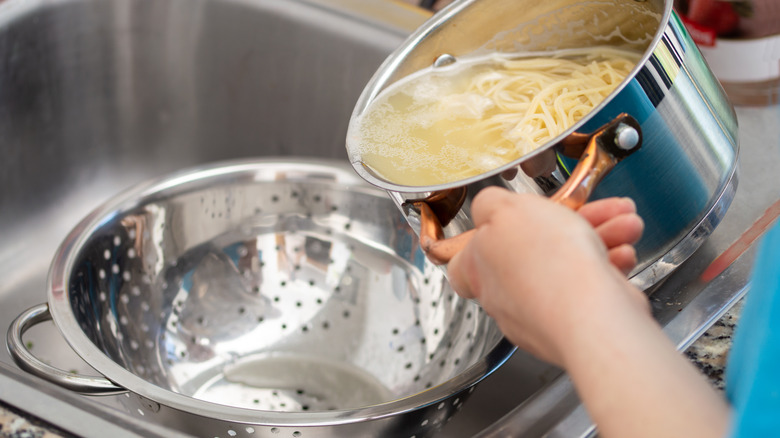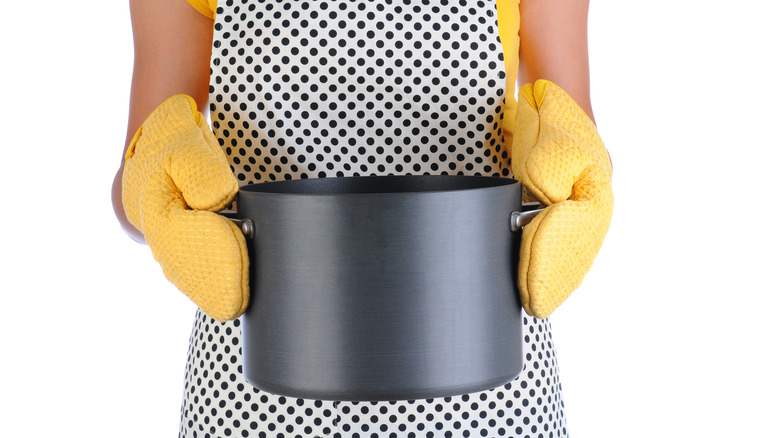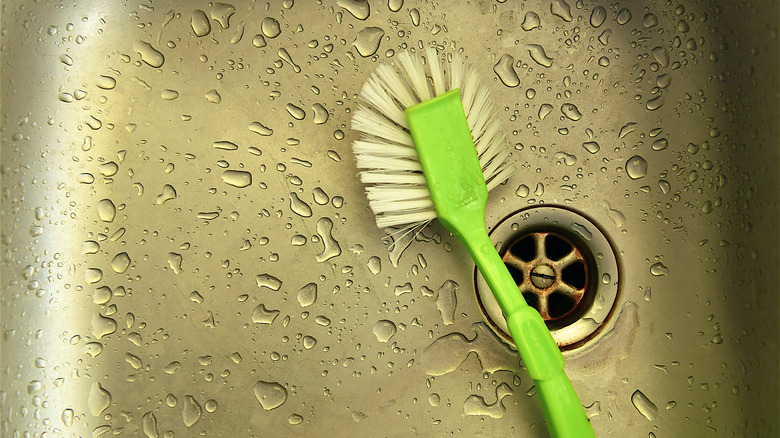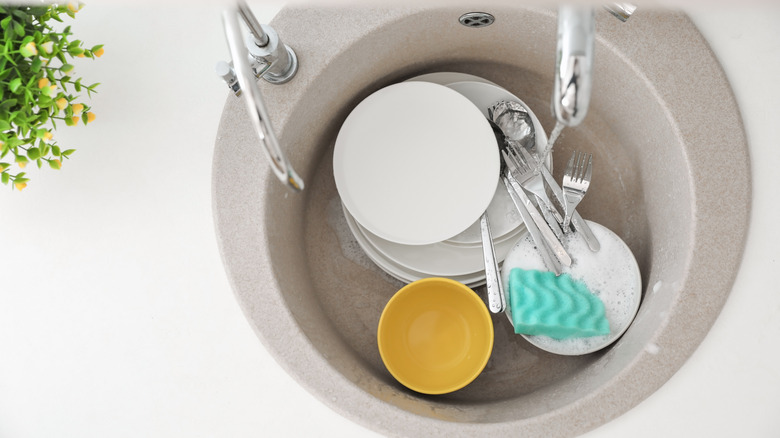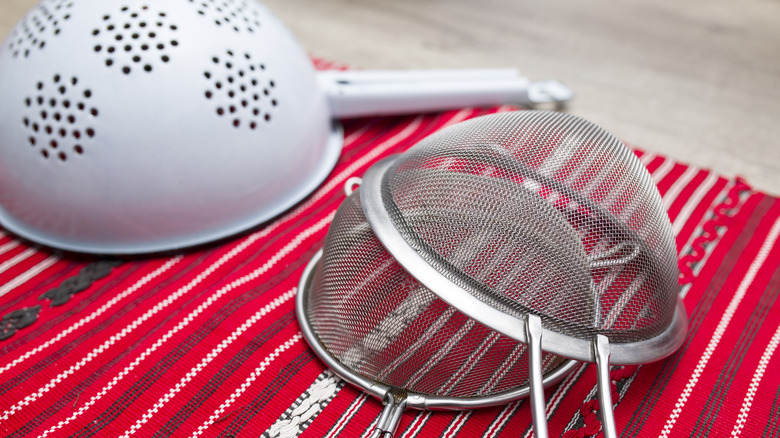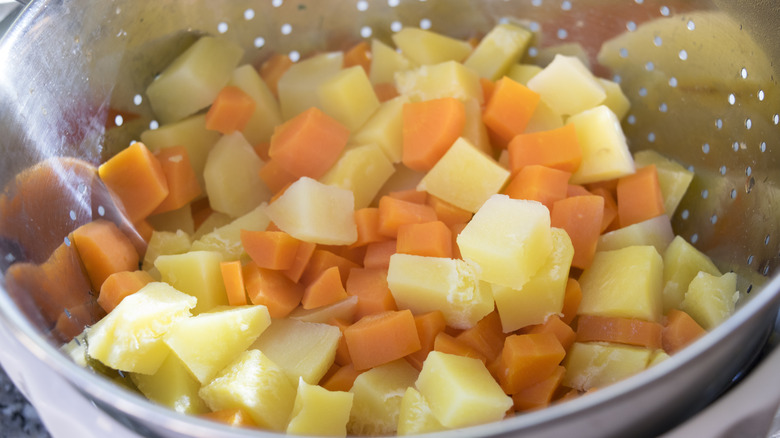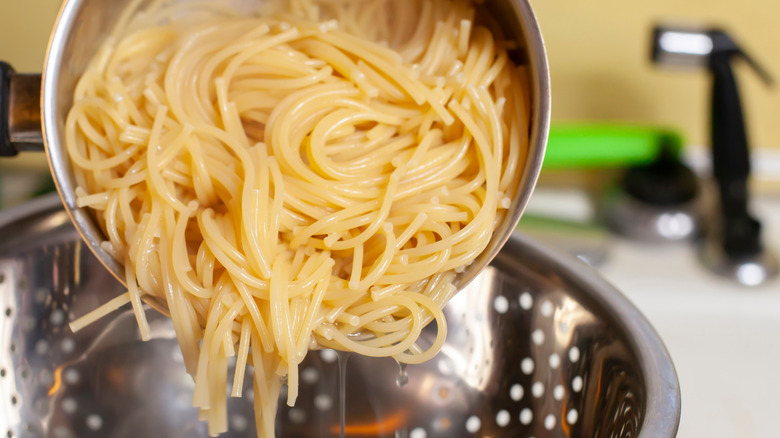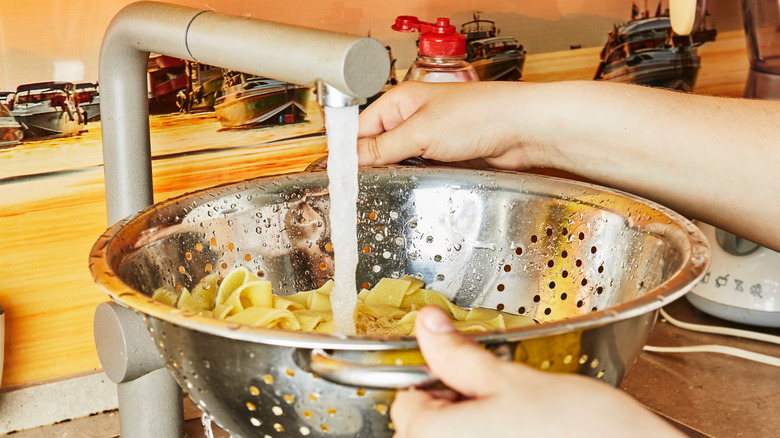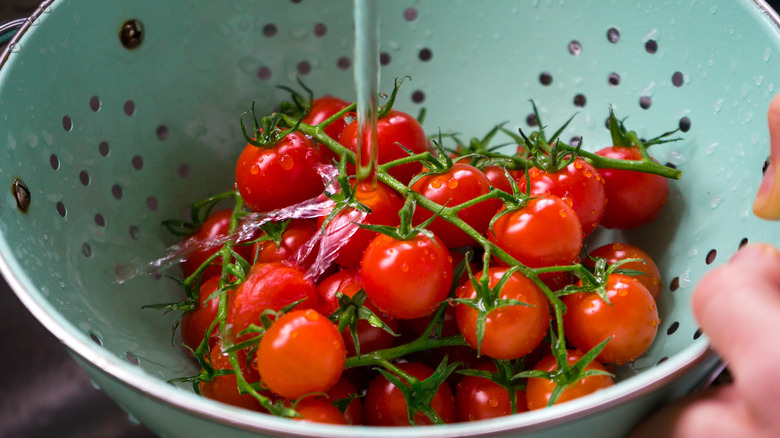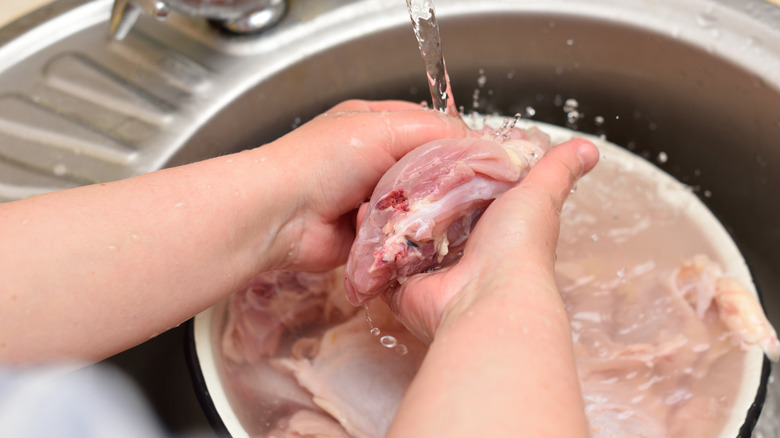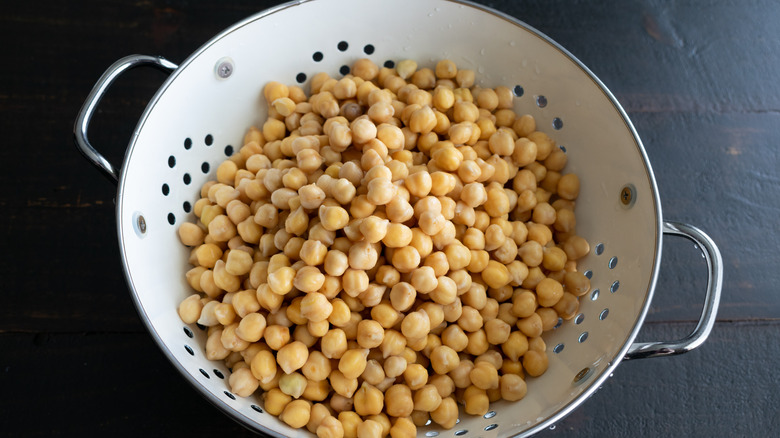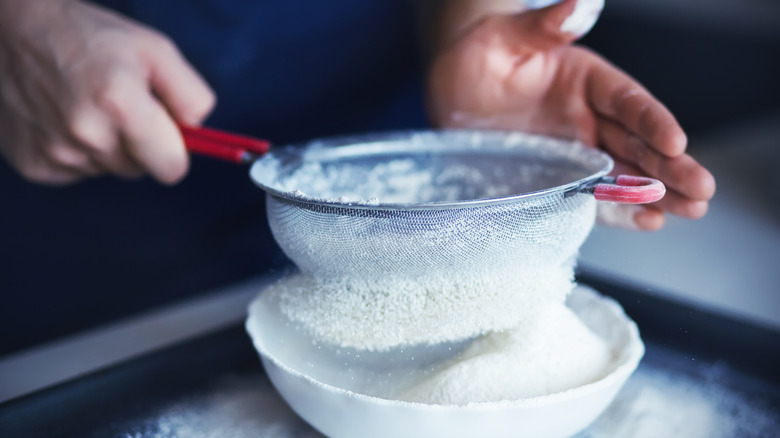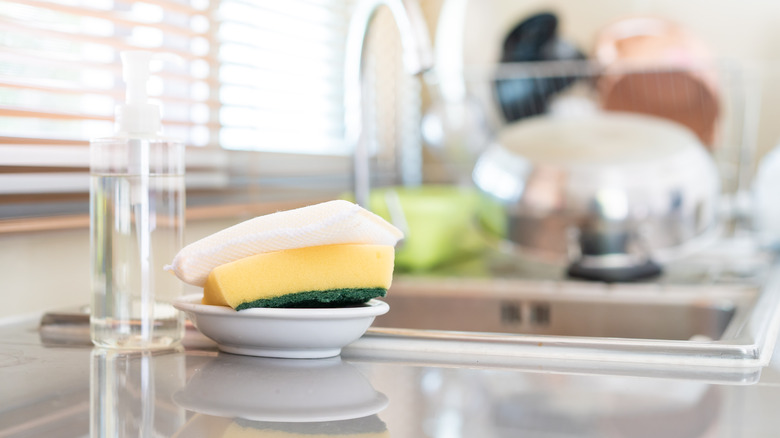13 Big Mistakes Everyone Makes With Their Colanders
It may be a humble kitchen utensil that's easy to use and has a simple job to do. But the colander is both uniquely capable of doing its primary job —draining pasta — and versatile enough to make you consider keeping an extra one or two on hand. We've definitely been guilty of taking our colanders for granted, but if you've ever needed it and your only one is dirty or in the middle of a dishwasher cycle, you know how important this multitasker really is.
But taking it for granted isn't the only colander faux pas we've made. These mistakes range from the inconvenient to the downright dangerous, but it's easy enough to avoid them once you know how. Even better, we list the mistakes that can simply mean we're missing out on some of the handy, clever, and totally useful tasks this small but mighty piece of metal (or plastic, or silicone) can accomplish in the kitchen.
1. Using a viral TikTok hack
A TikTok hack that claimed we've all been using our colanders wrong went viral in early 2021. And it looks good. You simply dump the water out of your pot through the colander, placed at the top of your pot, instead of into the colander in the sink. This way, the noodles never leave the pot, and you've presumably reached full colander mastery.
But wait — what if this isn't actually any more convenient than the way we've all been doing it forever? What if the colander doesn't fit right over your pot and you lose a bunch of noodles? What if you have more water in your pot than you bargained for and it burns your hands as you struggle to hold both the pot and the colander, which are hot and full of boiling water?
Yeah, this hack looked undeniably cool but was swiftly debunked by professional and celebrity chefs alike (per Yahoo). Sometimes, the boring old-fashioned way really is the best way — for good reason.
2. Forgetting the potholders
We've all been there. You're in a rush, juggling a dish or two on the stovetop and another in the oven. Or there's a conference call in your headphones while the baby is trying to open the "baby-proof" cabinet locks. Thinking or not, you grab the pot handles bare-handed. You might be lulled into a false sense of security because the handles aren't even that hot. Flying by the seat of your pants is paying off. You pulled a fast one. Or maybe not so fast. When you go to pour out the contents of your pot, are you always in control of the direction of the steam? Have you ever seen or had a steam burn? Science Daily explains their "vicious" effects: they are nasty, and you do not want one.
Let this be your friendly reminder to save your hands (and even your floors, since you might reflexively drop a hot pot if you touch it with bare hands). As Today explains, it's best to just put on the potholders to drain your pasta safely. And try not to lean directly over your pot or colander, either. You don't want to burn your face!
3. Leaving standing water in your sink
Familiar with the term mise en place? Translated and explained by the Spruce Eats, the French term is all about preparation, and a reminder to make sure everything is in its place before you start cooking. Dirty (or even questionable) water's place is most definitely down the drain. A little water in the sink is easy to overlook and might seem harmless even when you do notice it. But standing water is a prime breeding ground for bacteria that can carry waterborne illnesses. According to Dr. Charles Gerba via Food & Wine, "There's more E. coli in a kitchen sink than in a toilet after you flush it."
Eliminate the conditions for E.coli and other bacteria to grow. Remove any pots or pans containing standing water and give your garbage disposal a spin before you place your colander in the sink. Even better, make sure to regularly clean your sink with disinfecting cleaner. Don't let dirty water (or a dirty sink) contaminate your beautiful, freshly boiled pasta.
4. Leaving utensils or dishes in the sink under the colander
And dishes' place? Anywhere but the sink — when you're making pasta. Wash or remove any dirty dishes in the bottom of your sink to make a clean slate for setting your colander down on a stable surface. We already know a dirty sink is not ideal, but beyond being unhygienic, a colander that's crooked because it's resting on an unstable base of dirty dishes can easily tip over from the weight of the water and pasta. And there goes your whole pot of ruined noodles. Nobody has time to start their whole dinner over because of a misplaced set of dirty tongs. Take it from our experience (and a few too many noodles overboard). Even worse, a spilled colander can unleash boiling water where you don't want it and burn your hands or arms, or cause a big old mess on your counters.
Prefer not to worry about where your dishes are, or if your colander is on steady footing? Food & Wine recommends this handy (and cute) over-the-sink colander that keeps your food elevated and secure over any dishes, water, or germs in the sink below.
5. Using the same type of colander for different dishes
Don't let your pasta slip through the cracks — literally. Some colanders come in sets of different sizes and include ones with different-sized holes. Before you strain, make note of the size of your noodles and make sure you won't lose any when you drain them.
Finer mesh colanders or strainers are best for straining capellini, angel hair, and orzo pasta shapes. Metal colanders with larger holes should work well with a wide variety of other noodles. You probably want to avoid using the fine mesh strainer (or sieve) when you can, though, as these can be a special pain to clean. (Even Bon Appetít recognizes this inconvenience, and offers pointers for cleaning yours.)
Sometimes, for those larger noodles, you can even skip the colander altogether and use a spoon-shaped claw, as the Kitchn suggests, or pair of tongs to grab your noodles out of the water and transfer them directly to your dish.
6. Not using the colander to steam veggies
Who needs a whole separate piece of kitchen equipment for steaming vegetables taking up precious space in your cabinets? Not us, especially when a colander can do double duty (and so much more). As long as your colander or strainer is made of heat-safe materials, you already have a steamer basket at the ready.
The Kitchn explains how to steam veggies in a colander. First, make sure to use a pot that accommodates the size of your colander. It's important that you can place the colander inside without it touching the bottom of the pot. And while you're at it, check that the colander will be easy to remove (handles are outside of the pot, for example) before you start cooking. Add 1 inch of water to the pot, then a colander filled with washed vegetables and bring to a boil. Cover and steam as your recipe directs or until vegetables are crisp-tender.
7. Draining every last bit of water out of the pasta
Whatever you do, don't dump all that pasta water down the drain. Big mistake. Pasta water is precious! It's so important, Bon Appetít refers to it as "liquid gold." It's infused with starch from the noodles, and when you reserve pasta water to mix in with your desired sauce, it helps give sauce a thicker, silkier texture that adheres to the noodles way better than sauce and noodles alone. One food writer at Serious Eats did side-by-side tests to show the difference between sauce with pasta water and without it.
To get the most out of your pasta dish, either reserve a large ladle of pasta water before straining your noodles, or don't fully strain all the water out and leave some in the pot with the noodles. Better yet, the Kitchn suggests carefully placing a large bowl under your colander in your sink to catch and reserve that "liquid gold."
8. Rinsing pasta with water in the colander
Pasta water = precious, remember? Even worse than dumping all of your pasta water down the drain — and missing out on getting to mix it into your sauce for a thick and silky texture — is this cardinal sin of the sink. Rinsing off your noodles after cooking and straining not only strips them of the starches left on their surface but it can also change their temperature according to the imprecise temperature of your tap water.
According to the Kitchn, there are two (and only two) scenarios in which you should actually rinse your noodles: one is for making pasta salad and the other is for tossing noodles into a stir fry noodles. Rinsing the starches off in both of these cases will prevent the noodles in these dishes from clumping or sticking together, which is what you actually want for pasta salad and stir fry.
9. Not using your colander to wash fruits and veggies
Who actually has the time to slowly wash each individual piece of produce before you even get down to the business of cooking? Not us! And it's not worth the risk of food-borne illness to skip washing your fruits and vegetables altogether. Save yourself some time and effort by washing your produce in your colander. Place all the fruits and/or veggies you can fit in a colander and rinse it under cool water. Tougher produce may even hold up under your faucet's sprayer. It's a much faster and easier way to wash your produce than by hand.
A colander works especially well for strawberries and other fruits with tougher flesh. For more delicate berries, the Washington Post recommends putting berries inside the colander and the colander inside a bowl of clean water. Gently toss the berries to remove excess dirt and residue.
10. You're rinsing meat in your colander
Raw chicken and other meat can play host to bacteria such as salmonella. So washing it in the colander, like your veggies, makes sense right? Wrong. Washing chicken and other meat in the colander is not only unnecessary (cooking is the only way to kill the bacteria in chicken and other meat), but also potentially dangerous to your health.
According to the Partnership for Food Safety Education, washing chicken in a colander does not kill bacteria but can spread it to other surfaces and foods in your kitchen — including raw veggies that are ready to eat. Imagine washing chicken in your colander and then washing lettuce — which you'll eat raw —in the same colander. Not ideal, and not safe, either.
Skip rinsing your raw meat. To kill the bacteria in your chicken, always make sure to cook it to a safe internal temperature of 165°F. Check it with a meat thermometer before removing it from the heat.
11. Not using the colander to drain canned goods
Think you don't need any extra equipment when it comes to draining canned foods? Do you enjoy awkwardly pushing the half-removed top of an aluminum can into the food and straining most of the water (but maybe not all of it)? Do you enjoy handling the sharp edges your can opener made on the top? If so, you can totally drain canned beans, fruit, and vegetables through that tiny, jagged metal opening in the top of the can. But why would you when you can easily strain them all through a colander?
Save your fingers and your sanity by putting your colander to use when it comes to straining canned foods. If your recipe calls for rinsing the canned beans or vegetables, you can easily do so in the colander as well. As we discovered here at Mashed, whether the recipe specifies or not, you may even want to rinse all of your canned goods to reduce their sodium content before you cook.
12. Not using the colander to sift flour
If you haven't sifted your flour before, let this be the day you start. Sifting your flour can lead to much better baked goods. But you don't have to buy a sifter if you have a colander. The Kitchn explains that you can sift with a strainer or colander over a large bowl, holding the colander in one hand and lightly tapping it with the other. If you are sifting other dry ingredients together with the flour, sift it an extra time or two.
Another thing to consider when it comes to sifting: the experts at Cook's Illustrated point out how to know if you should sift flour before or after measuring. According to them, "1 cup sifted flour" means you should sift before measuring. On the other hand, "1 cup flour, sifted" means you should sift after measuring. Why does this matter? Because sifted flour can weigh 20-30% less than non-sifted, resulting in a huge difference in the amount of flour you use. If a recipe doesn't specify, you can play it safe and sift after measuring.
For the most precise results, try measuring your flour by weight on a kitchen scale that's ideal for baking.
13. Not washing your colander (or at least rinsing) immediately after use
Doesn't the pasta water kind of wash the colander for you? It's very hot water passing through, after all. Not so fast. Your colander might seem clean enough, but as CNN points out, lots of places in the kitchen can grow potentially harmful bacteria without regular (and thorough) cleaning.
Pieces of stuck-on pasta that you can see and pasta starch and residue that you may not be able to see will both be much easier for you to wash off if you tackle the chore right after use. If you can't give it a proper scrub right away, at least rinse it out to prevent pasta remnants from fully drying on it. Finish washing it in your clean sink, with hands that are safely free of steam burns, after you enjoy your delicious noodle dish that's covered in the silkiest pasta water-infused sauce.
